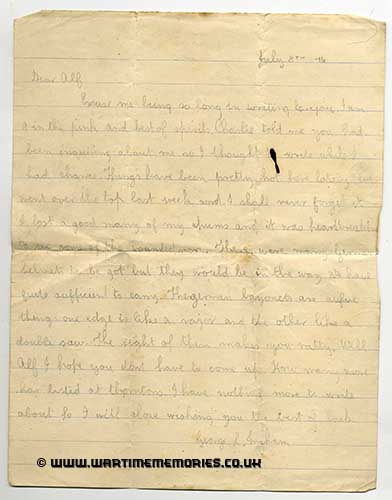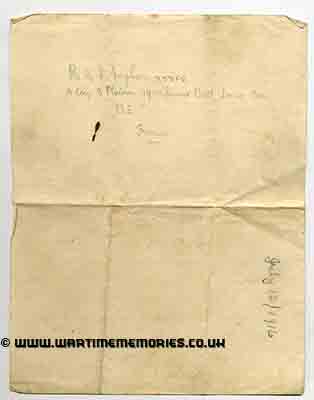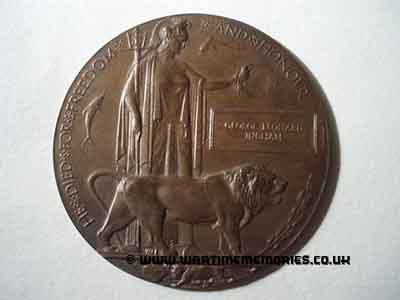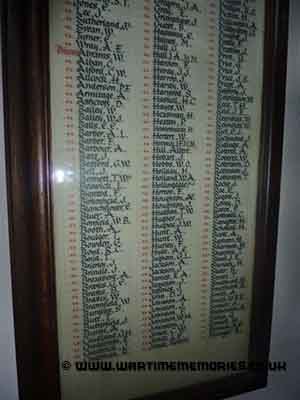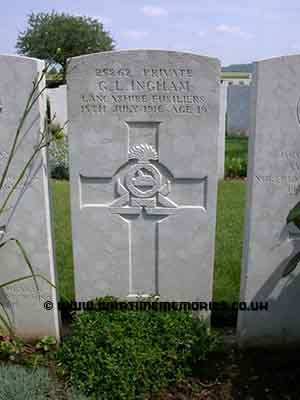Additions will be checked before being published on the website and where possible will be forwarded to the person who submitted the original entries. Your contact details will not be forwarded, but they can send a reply via this messaging system.
please scroll down to send a message
Pte. George Leonard Ingham
British Army 19th Battalion, A Company, 3 Platoon Lancashire Fusiliers
from:Rochdale
(d.15th July 1916)
I knew that my Grandmother and Grandfather on my Mother's side had both lost a brother in WWI. Stupidly, I never asked any questions. Last Nov. 11, I decided to research them on the internet as I knew their names. My Grandmother's Brother was named George Ingham. I easily found him on the Commonwealth War Graves' site. After finding his details I input his info in Google and was taken to a page that showed his gravestone and a scan of a letter. The letter was put there by the niece of its recipient, Alf Plater. Alf was a friend and co-worker of George's in a small mill call Thornton's outside Rochdale.
The letter is dated July 8th, 1915, one week before George's death. It describes the 3rd Salfords' disastrous attack on the Leipzig Redoubt near Thiepval on the first day of the Battle of the Somme on July 1, 1916. The Salfords were depth reserve for several other battalions in the first wave. When it came time for them to advance, the British front line and communications trenches were so clogged with wounded that the battalion had to advance over open ground to the British front line. Similar to the preceding Lonsdale battalion (11th Border) and the 1st Dorset battalion, the Salfords suffered crippling casualties form German machine guns firing in enfilade from a fortification call the Nordwerk. Of the battalion's 4 companies, only A, B and one half of C were sent 'over the top.' The other half of C and D company both remained under cover once it was realized that committing them would just add to the massacre.
From the battalion war diary: "In the meanwhile A, B and part of C Company had continued their advance from the front line trenches in waves of 30 or 40 men. The leading wave, led by Lt Huxley, got within 10 yards of the German trench but out of forty men only four remained and they could get no further."
"Capt Hibbert led the next wave and succeeded in getting into the German trench. He was followed by Lt Musker and 2nd Lt George with all the men that could be collected. These were the only three officers left with the two and a half companies that had advanced, the remaining officers having been killed or wounded."
"During these operations the battalion experienced 268 casualties, that’s to say 50% of its fighting strength, having 20 officers and 577 other ranks when going into action." Note that this 50% battalion casualty rate was incurred but just over one half of the battalion. Casualties in A, B and the part of C company that advanced were at a much higher rate. In George's A company, the CO Lt. Huxley was wounded at duty and all three platoon commanders were killed in action.
George's understated letter describing this catastrophe says:
'July 8th, 1916
Dear Alf
Excuse me being so long in writing to you. I am in the pink and best of spirits. Charles told me you had been inquiring about me so I thought I should write when I had the chance. Things have been pretty hot here lately. We went over the top last week and I shall never forget it. I lost a good many of my chums and it was heartbreaking to see some of the wounded men. There were many German helmets to be got but they would be in the way. We have quite sufficient to carry. The German bayonets are awful things one edge is like a razor and the other like a double saw. The sight of them makes you ratty. Well Alf I hope you don't have to come up. How many more have listed at Thorntons. I have nothing more to write about so I will close wishing you the best of luck.
George L. Ingham"
After July 1, the 3rd Salfords were reorganized into only 2 companies. They were next in the line on July 12 at Ovillers. Interestingly one of the neighbouring battalions was the 11th Lancashire Fusiliers, where JRR Tolkien was serving as the battalion signals officer. George's battalion had Tolkien's best friend, Lt. Geoffrey Bache Smith, as its Intelligence Officer. Smith would be killed weeks later, leaving Tolkien the only survivor of his school friends who joined the British army.
In the vicious close quarter warfare in the Ovillers trenches, George's combined company was heavily engaged, again losing two of three plat0on commanders killed and one wounded. George Ingham was mortally wounded, likely by a German sniper. Per the battalion war diary most of the casualties of this fighting were due to snipers. The fact that he was evacuated to the clearing station at Warloy Baillon in the rear supports this assumption as this clearing station focused on serious head and abdominal injuries. George Ingham died of his wounds July 15th, 1916 aged 19 years. He is buried in the Communal Cemetary Extensionn at Warloy Baillon.
